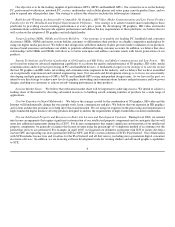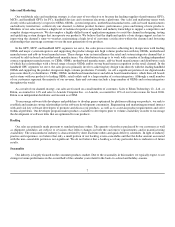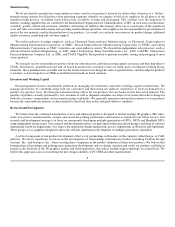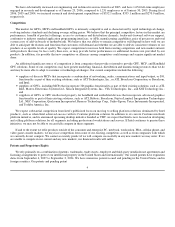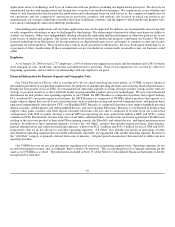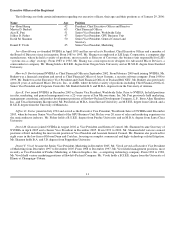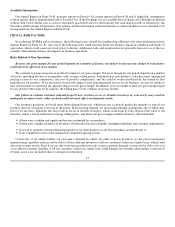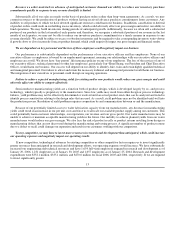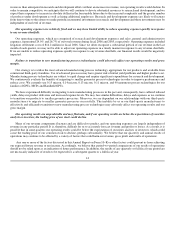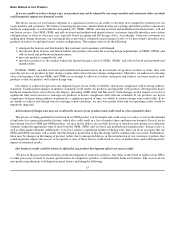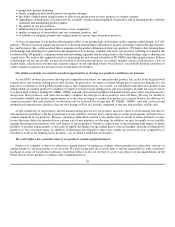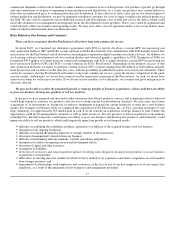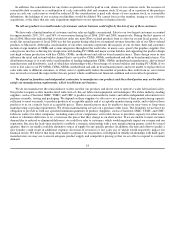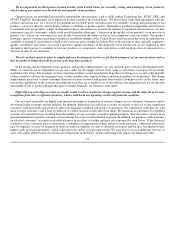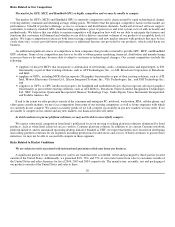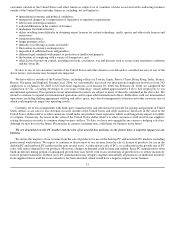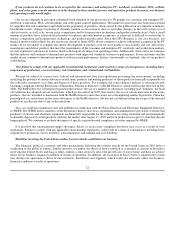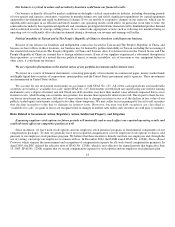NVIDIA 2006 Annual Report Download - page 19
Download and view the complete annual report
Please find page 19 of the 2006 NVIDIA annual report below. You can navigate through the pages in the report by either clicking on the pages listed below, or by using the keyword search tool below to find specific information within the annual report.
Because we order materials in advance of anticipated customer demand our ability to reduce our inventory purchase
commitments quickly in response to any revenue shortfalls is limited.
Substantially all of our sales are made on the basis of purchase orders rather than long−term agreements. As a result, we may
commit resources to the production of products without having received advance purchase commitments from customers. Any
inability to sell products to which we have devoted significant resources could harm our business. In addition, cancellation or deferral
of product orders could result in our holding excess inventory, which could adversely affect our gross margin and restrict our ability to
fund operations. We may build inventories during periods of anticipated growth. Additionally, because we often sell a substantial
portion of our products in the last month of each quarter and, therefore, we recognize a substantial portion of our revenue in the last
month of each quarter, we may not be able to reduce our inventory purchase commitments in a timely manner in response to any
revenue shortfalls. We could be subject to excess or obsolete inventories and be required to take corresponding inventory write−downs
if growth slows or if we incorrectly forecast product demand, which could negatively impact our gross margin and financial results.
We are dependent on key personnel and the loss of these employees could negatively impact our business.
Our performance is substantially dependent on the performance of our executive officers and key employees. None of our
executive officers or employees is bound by an employment agreement, meaning our relationships with our executive officers and
employees are at will. We do not have “key person” life insurance policies on any of our employees. The loss of the services of any of
our executive officers, technical personnel or other key employees, particularly Jen−Hsun Huang, our President and Chief Executive
Officer, would harm our business. Our success will depend on our ability to identify, hire, train and retain highly qualified technical
and managerial personnel. Our failure to attract and retain the necessary technical and managerial personnel would harm our business.
The integration of new executives or personnel could disrupt our ongoing operations.
Failure to achieve expected manufacturing yields for existing and/or new products would reduce our gross margin and could
adversely affect our ability to compete effectively.
Semiconductor manufacturing yields are a function both of product design, which is developed largely by us, and process
technology, which typically is proprietary to the manufacturer. Since low yields may result from either design or process technology
failures, yield problems may not be effectively determined or resolved until an actual product exists that can be analyzed and tested to
identify process sensitivities relating to the design rules that are used. As a result, yield problems may not be identified until well into
the production process. Resolution of yield problems requires cooperation by and communication between us and the manufacturer.
Because of our potentially limited access to wafer fabrication capacity from our manufacturers, any decrease in manufacturing
yields could result in an increase in our per unit costs and force us to allocate our available product supply among our customers. This
could potentially harm customer relationships, our reputation, our revenue and our gross profit. Our wafer manufacturers may be
unable to achieve or maintain acceptable manufacturing yields in the future. Our inability to achieve planned yields from our wafer
manufacturers would reduce our gross margin. We also face the risk of product recalls or product returns resulting from design or
manufacturing defects that are not discovered during the manufacturing and testing process. A significant number of product returns
due to a defect or recall could damage our reputation and result in our customers working with our competitors.
To stay competitive, we may have to invest more resources in research and development than anticipated, which could increase
our operating expenses and negatively impact our operating results.
If new competitors, technological advances by existing competitors or other competitive factors require us to invest significantly
greater resources than anticipated in research and development efforts, our operating expenses would increase. We have substantially
increased our engineering and technical resources and have 1,654 full−time employees engaged in research and development as of
January 29, 2006, 1,231 employees as of January 30, 2005 and 1,057 employees as of January 25, 2004. Research and development
expenditures were $352.1 million, $335.1 million, and $270.0 million for fiscal 2006, 2005 and 2004, respectively. If we are required
to invest significantly greater
13





